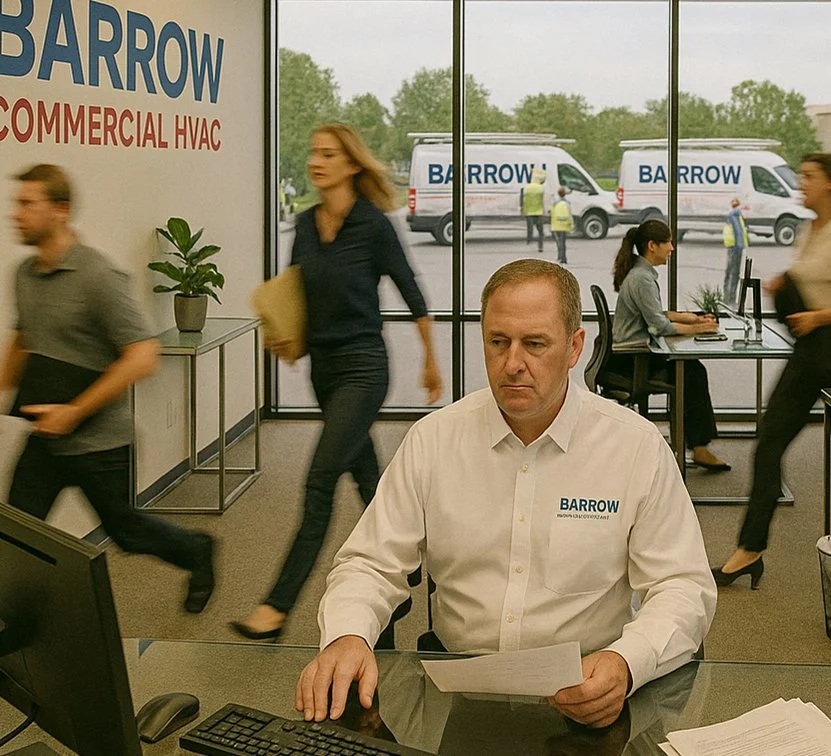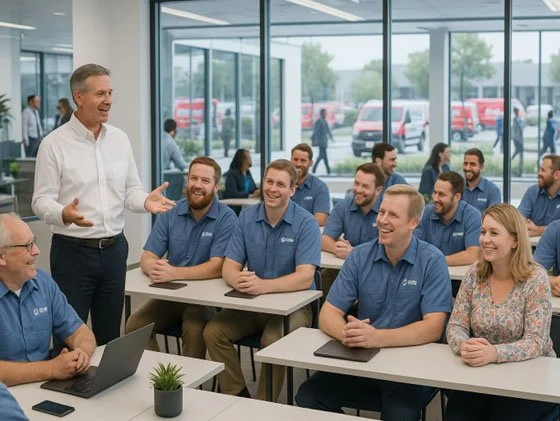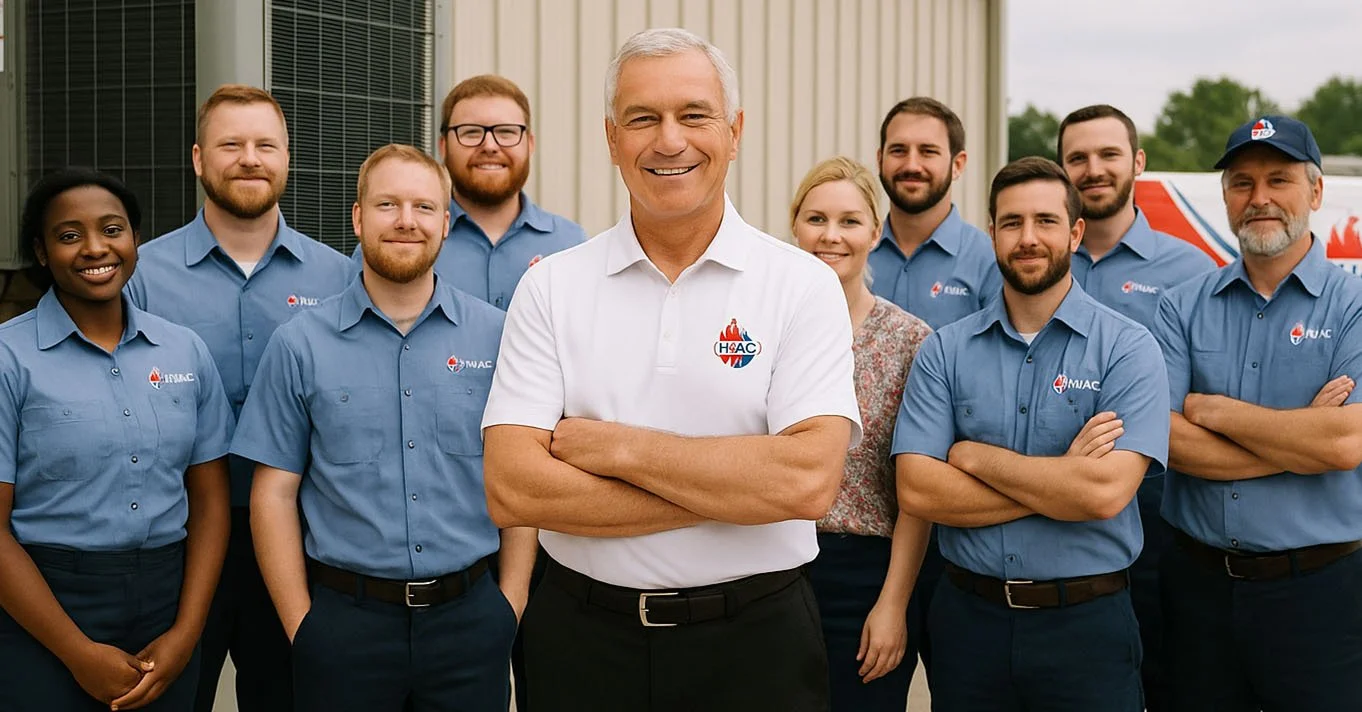R410A Phase-Out Guide for Commercial HVAC Owners
Feeling unprepared for the R410A phase-out? You're not alone.
Get clarity on what to do next and a free transition roadmap.
The R410A phase-out is not just another government rule. This major shift will impact every aspect of your commercial HVAC business, including systems, personnel, customers, and profits.
As a certified business and executive coach who works with commercial HVAC business owners across the US, I see how fast this change is moving and how few are truly ready for it.
The American Innovation and Manufacturing Act, known as the AIM Act, requires the EPA to cut the use and production of certain refrigerants by 85% by 2036. R410A is one of the main refrigerants being phased out.
Most HVAC companies have relied on it for years, but due to its high global warming score of 2,088, it’s being replaced with newer, cleaner options.
Here's what you need to know about the timeline:
Starting January 1, 2025, no more R410A systems can be manufactured or imported.
Systems made before 2025 can be installed through the end of 2025, though HVAC contractors are advised to clear all R410A inventory by December 31, 2025.
For commercial systems, the timeline varies by type.
Comfort cooling chillers faced a January 1, 2025, installation ban,
While variable refrigerant flow systems have until January 1, 2027. EPA
The new refrigerants have much lower global warming potential. R32 has a GWP of 675, and R454B has a GWP of 466. These are part of a class called A2L refrigerants, which means they're mildly flammable.
This is not a simple swap. You cannot refill an R410A system with R454B. The entire design, from compressors to coils, must be built to handle the new refrigerant safely.
Here's the good news: You can continue to repair and service your existing R410A systems. R410A refrigerant will continue to be produced until 2034, steadily dropping to about 20% of today's production.
This means replacement parts will stay available for existing systems throughout their useful life.
But here's the bad news: as production drops, prices will climb. We've already seen this happen with R22, which increased roughly 20% year over year, a total jump of 516% over ten years.
The R410A phase-out affects both residential and commercial systems, but commercial owners face bigger challenges.
Residential units can be swapped out quickly. Commercial systems are complex, costly, and often tied into building automation systems across multiple locations.
This R410A phase-out will compel you to reassess your equipment purchasing, team training, and pricing strategies. Manufacturers are already rolling out systems with new refrigerants, and technicians will need training to handle them safely.
This isn't just about the environment. It's about protecting your business and staying competitive in a rapidly changing market.
Table of Content
Why Most Owners Are Not Ready for the R410A phase-out
When I ask HVAC business owners how prepared they are for the R410A phase-out, most give me the same answer: "We'll deal with it when we have to." That's a risky approach.
The HVAC industry has a history of waiting until regulations take effect before reacting. We saw it with the R22 phase-out, and the pattern is repeating.
But the timeline on this transition is aggressive. Equipment prices are already climbing, and manufacturers are shifting production to meet the new standards.
The EPA has set clear restrictions that get tighter every year. Starting January 1, 2025, new air conditioning and heat pump systems cannot be manufactured or imported using refrigerants with a global warming potential at or above 700.
Most manufacturers have already stopped making R410A equipment and switched to systems using cleaner refrigerants. This creates a closing window for commercial HVAC companies to make smart choices about equipment purchases, technician training, and service capabilities.
In my experience as a business coach working with commercial HVAC owners nationwide, the companies facing the biggest challenges are those without a transition plan.
The Financial Impact You Can't Ignore
The R410A phase-out isn't just another rule change. It's a money issue that's already affecting HVAC companies.
Manufacturers are redesigning systems to meet new safety standards for A2L refrigerants. These systems need spark-resistant parts, leak detectors, and other safety features. That adds cost.
Industry analysts expect price increases for new commercial systems in the next year.
I recently spoke with one of my clients in Boston, MA, who had budgeted $240,000 for equipment replacements in 2025 based on 2024 pricing.
When we recalculated using the projected A2L equipment costs, his real number came out closer to $276,000. That's an extra $36,000 he hadn't planned for.
Because we caught it early, he had time to revise his budget and get the extra money that was needed.
As the supply of R410A gets cut under the EPA's production allowance schedule, prices are climbing. During the earlier R22 phase-out, refrigerant prices increased substantially, with some periods seeing annual increases of 20% or more.
The same pattern is starting again with R410A.
The Hidden Cost: Training and Getting Ready
A2L refrigerants aren't hard to use once your team learns how, but they work differently from what your techs are used to. These new refrigerants can catch fire more easily than R410A, so your team needs to know how to find leaks, keep work areas ventilated, and handle equipment safely.
That means new safety rules, special tools, and updated certifications. Your technicians need gauges and tools rated for A2L refrigerants. They also need the right safety gear. This sounds simple enough until you realize most companies haven't set aside money for it yet.
Training is available right now through industry associations and EPA-approved providers. Courses cover A2L refrigerant fundamentals, system replacement, refrigerant charge verification, installation procedures, and ongoing service and maintenance.
Here's the catch: training takes time.
While your technicians are in class, they're not earning money for your company. The longer you wait, the harder it will be to get into training programs before everyone else rushes in as the R410A phase-out deadline gets closer.
Your technicians also need updated skills for brazing and torch work around refrigerants that can ignite.
Protecting your business matters. Proper A2L training records protect you from legal claims. Safety rules around mildly flammable refrigerants create new risks if something goes wrong.
One of my clients owns a $22 million commercial HVAC company outside of Boston, MA.
He trained his whole team early in 2024. Between lost work time, course fees, and additional safety equipment, it cost him several thousand dollars and three days of productivity.
But within six months, he won three new commercial service contracts because he could prove his company was "A2L Ready." That's how early preparation turns spending into profit.
How to Think Strategically About the Transition
Your HVAC business strategy for this transition must include three key stages.
Start simple. Assess your current systems, prioritize replacements, and plan budgets. Then build a communication strategy for your team and your clients.
Your people need to understand why this matters. Your clients need to understand why costs may rise.
Transparency builds trust.Building owners need to understand they don't need to replace existing systems immediately. According to the EPA, you can continue to service existing R410A equipment. Create a roadmap showing when replacement makes sense based on equipment age, efficiency, and refrigerant availability.
Think in stages:
First: get your leadership and technicians aligned.
Second: complete the training, buy the right tools, and choose your replacement systems.
Third: use the transition to reprice your contracts and position your company as the expert.
In my executive and business coaching work, the owners who succeed aren't necessarily the biggest. They're the ones who plan in advance, align their teams, and execute deliberately.
Behind on the R410A transition? You're running out of time.
Get your action plan now in a free strategy session.
Turning Compliance into Competitive Advantage
HVAC contractors who delay face mounting pressures.
Under the EPA's phasedown, HFC production drops 70% by 2029 and 85% by 2036. That means tighter supply, higher refrigerant costs, and constrained equipment availability.
Meanwhile, your competitors who planned early are marketing compliance readiness, capturing bids, and positioning themselves as the safer choice.
But here's the opportunity: compliance sells when you communicate it correctly. Your clients want partners who stay ahead of the curve.
When you demonstrate readiness, trained technicians, proper tools, low-GWP expertise, you're not just checking a box. You're signaling that your company is reliable, forward-thinking, and lower-risk.
Stop saying "We have to switch refrigerants." Start saying "We've invested in EPA-compliant
technology that makes your clients' systems safer, more efficient, and ready for upcoming regulations. We can help you create strategic replacement plans that protect equipment investments."
That's the difference between cost and value. Without proper training documentation, you risk higher insurance premiums, coverage limitations, and liability exposure. With it, you position yourself as the contractor who plans ahead instead of reacting when forced.
What to Do Right Now
The first step is clarity. You can't lead your business through a transition if you don't know where you stand.
Start by identifying every R410A system you maintain, both for your clients and in your own facilities. Then prioritize.
Schedule training for your technicians now.
Contact your distributors and ask what A2L-compatible equipment they're bringing in.
Talk to your insurance provider about coverage and documentation.
Begin updating your maintenance contracts with clear language about compliance and refrigerant management.
Stay updated on EPA refrigerant regulations and compliance timelines.
Connect with certified reclaimed refrigerant suppliers to control costs as R410A production declines.
Build client communication materials that explain the phase-out clearly and position your company as the trusted advisor.
Create audit tools that help building owners understand their equipment inventory, replacement priorities, and budget requirements.
The most profitable commercial HVAC owners I coach have already budgeted replacements for the next two years. They're not waiting; they're building momentum.
Key Takeaways
The R410A phase-out is not a technical side note. It's a test of leadership, readiness, and profit discipline. The industry is shifting to low-GWP refrigerants because it has to, but how you respond determines whether you thrive or struggle.
You don't need to overhaul your business overnight. You need to start. Build awareness, schedule training, plan your replacements, and communicate with clarity. Show your clients and your team that you're in control.
Train your entire team on A2L safety protocols now. Under the EPA's phasedown schedule, HFC production drops 70% by 2029.
Companies with certified technicians and documented safety procedures will win bids while unprepared competitors face insurance issues and liability exposure.
Build strategic relationships with reclaimed refrigerant suppliers. As virgin R410A production declines through 2034, reclaimed refrigerant becomes increasingly important for servicing existing client systems cost-effectively.
The owners who treat this as an opportunity (not a nuisance) will come out stronger, more profitable, and more respected. The ones who wait will be playing catch
Frequently Asked Questions
What is R410A, and why is it being phased out?
R410A is a widely used refrigerant with a global warming potential of 2,088. The EPA's AIM Act is phasing it out to reduce climate impact by cutting HFC use by 85 percent by 2036.
Can I still use my existing systems?
Yes, you can continue to repair and service existing R410A systems. R410A refrigerant will continue to be produced until 2034, and replacement parts will remain available throughout your equipment's useful life.
Can I retrofit my current units with new refrigerants?
No. The new A2L refrigerants like R32 and R454B have different chemical and safety properties. Retrofitting is unsafe and not approved by manufacturers.
Are the new refrigerants safe?
Yes, when handled properly. A2L refrigerants are mildly flammable, but with correct training, leak detection, and ventilation, they are safe and efficient.
Where can my technicians get A2L training?
ACCA offers A2L Refrigerant Safety Training with five comprehensive modules for $35 (members) or $49 (non-members). The training includes system replacement, installation, commissioning, and service procedures.
What is reclaimed refrigerant, and should I use it?
Reclaimed R410A is a refrigerant that has been recovered, cleaned, and certified to meet EPA standards. As of 2024, 23 percent of R410A in use is reclaimed and recycled. It's a cost-effective option for servicing existing systems as virgin production declines.
Will this increase my costs?
Yes, in the short term. Expect increases between 10 to 25 percent in equipment costs, plus training and tooling expenses. But early action lets you control costs instead of reacting to shortages later.
What about liability and insurance?
Proper A2L training documentation protects against liability claims. Safety protocols around mildly flammable refrigerants create new liability exposure, so certification is essential.
What's the best next step?
Start now. Inventory your systems, schedule training, talk to suppliers, and build a transition plan. Create client communication materials that position you as the trusted advisor. Then use your readiness as a marketing advantage.
Don't Let This Transition Cost You
The R410A phase-out is the biggest shift in HVAC in over a decade, and the prepared contractors will be the profitable ones.
Facts:
Equipment costs are climbing 10-15%.
R410A prices are following the same spike we saw with R22.
Training programs are filling fast.
Competitors who moved early are winning bids.
The owners who wait will face emergency purchases, untrained teams, lost contracts, and margin erosion.
Smart HVAC business strategy means turning regulatory change into a competitive advantage, not reacting when it's too late.
As a certified business coach who has guided $5.0M-$35.0 commercial HVAC business owners through major transitions for 25+ years, I know what works and what costs you money.
No pitch. No pressure. Just a clear roadmap to complete your goal.




